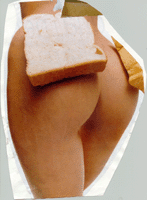 Is a woman
a piece of meat?! Is a woman
a piece of meat?!Students found this image in a magazine and brought it into class! |
![]() What
is sexual objectification?
What
is sexual objectification?
Judith Posner in Atkinson Review of Canadian Studies 1, Spring 1984 gives the following definition of objectification:
| Objectification is the "object-like character of an image that connotes passivity, vulnerability, property, and, in its most extreme form, victimization." |
John Berger's analysis of the difference between nakedness and the nude in Ways of Seeing can help us understand how women's sexuality is objectified.
In the European artistic tradition, nakedness becomes a symbol of women's submission (52). Berger uses Kenneth Clark's work The Nude to explain that a painting of a nude is conventionalized; it is "a way of seeing which the painting achieves" (53).
Study Berger's analysis of the nude as a tradition in European art on pages 52 - 64.
Write paraphrases of the following quotes from Berger's Ways of Seeing:
| To be naked is to be oneself. To be nude is to be seen naked by others and yet not recognized for oneself. A naked body has to be seen as an object in order to become a nude. (54) |
| Today the attitudes and values which informed that tradition [of the European nude] are expressed through other more widely diffused media -- advertising, journalism, television. But the essential way of seeing women, the essential use to which their images are put, has not changed. Women are depicted in a quite different way from men -- not because the feminine is different from the masculine -- but because the 'ideal' spectator is always assumed to be male and the image of the woman is designed to flatter him. (63-4) |
Complete these activities and answer these questions.
- Why does Berger say that a painting of a nude "turns desire into fantasy?" (60) Why does it portray the woman "as a thing or an abstraction?" (62)
- Find ads that seem to objectify women. Explain how the women are made to appear passive and vulnerable. What are they doing? How are they posed?
 Listen
to this clip from Ani Difranco's "Not A
Pretty Girl." If you have access to the whole song and the
CD of the same name, listen to that too. How does Ani's work oppose
the sex object stereotype.
Listen
to this clip from Ani Difranco's "Not A
Pretty Girl." If you have access to the whole song and the
CD of the same name, listen to that too. How does Ani's work oppose
the sex object stereotype.- Find ads where women appear with men but seem to be their property. How are they positioned relative to the men? Who is more active in the ad? Where are the people looking? What are they doing? Who is in the foreground?
- Find ads that treat men as sex objects. Compare images of women and men and consider whether there are any differences in the nature of the objectification.
- What is the difference between an object and a person? How do the women in ads appear "unreal," not like real human beings?
- Whose interests are served by women's being treated as sex objects?
 Link
to analyze a famous photograph by artist Ruth Orkin, American Girl
In Italy." (1951)
Link
to analyze a famous photograph by artist Ruth Orkin, American Girl
In Italy." (1951)
